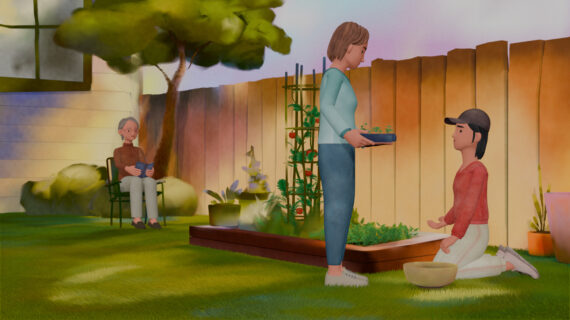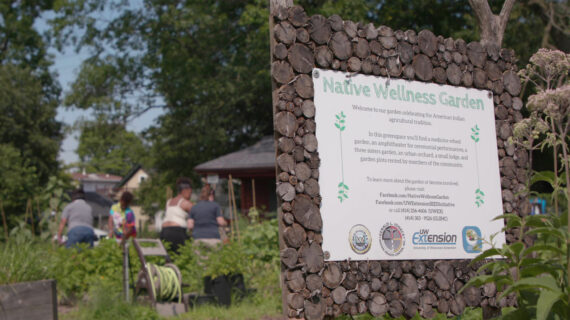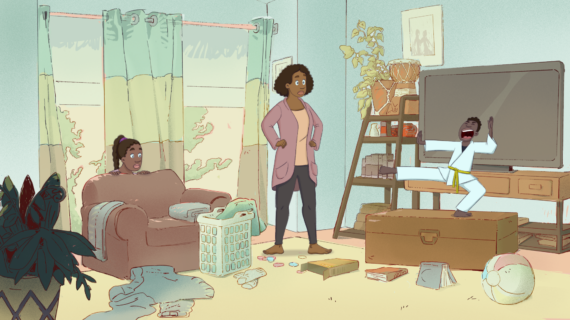– Nika: Hello, everyone, hi. – Audience: Hello! – I’m Nika Vaughan, and I’m the owner and founder of Plant Salon. And we are a plant shop and self-care boutique in Chicago. If you’re on Instagram, we’re @PlantSalonChicago. And we do ship. We go all over, so we’re so happy to be here in Madison. Hey. And today, we’re gonna be talking about cultivating plant homes, and that is really for both you and your plant. It is a partnership. But we’re gonna start off with the plants, and what they need.
Everyone has needs. It’s important to recognize both the plant and you as the plant owner have needs that have to be considered. Needs will change as both yours and the plant’s priorities change. So in the photos here, the inset photo is, this was an anthurium queen. I think a little, like a chunk, somebody gave me a little sliver of one and I was like, “Oh, I love a rehab.” But you know, you have to kind of like, “What kind of moss do I wanna put it in? I’m gonna be very mindful of the humidity. I wanna mist it maybe versus watering it so it has high humidity, but it doesn’t get soggy.” It’s a higher needs relationship than say, in the other photo is of, that is a philodendron plowmanii and anthurium regale, and they are just big and showy. They’re mature, they’re settled. They definitely still have their needs, they wanna be in good spots with light, but they’re a little bit more established than a higher needs, propagating, rehabbing plant.
This photo, these were cuttings I got from a variegated ZZ plant, which especially in the Midwest can be a very slow grower. They don’t ship well either. So when I got it, I was like, “I need some insurance in case this one doesn’t make it. Let’s get some babies started.” And so that’s what’s in my coworker’s hand here, is the rhizome is growing at the base of the leaf. So if you have a plant that you love, making some propagations might be a great way to ensure that if the worst were to happen, a cold snap, a very inquisitive pet or something, then you’ve got some backup. So you wanna start with studying your successes. I think it’s really helpful when you’re plant shopping, you walk in a shop, it’s so exciting. You wanna take one of everything home. What’s worked out in the past? What plants do you have the most success with? What growing conditions do you have the most success with? Are the varieties of plants that are best suited for the conditions you can provide? And where are most of these plants from natively? It’s good to have these parameters in mind, and then we’re gonna start to look for what plant we wanna get.
So this is diagnosing what we’ve already had, and things did not go well. And instead of mourning the, “Oh, it didn’t work out,” or “I overdid a thing.” We’re gonna treat it like we’re a detective. This is research, we’re a scientist. And we’re gonna look for clues about what we could do differently and what maybe caused the plant to take a downturn. This is really key when you’re on your third or fourth attempt with a certain plant, maybe like a string-of-pearls. Some people are like, “I can’t keep cactus and succulents alive.” I’m like, “What do you do?” “I water it every other day.” You’re like, “That pattern might be the problem there.” You know? Looking for signs.
What is the plant telling you about what’s going on? Are the plant’s leaves and stem dry, brittle, or crunchy? And especially in house plants where you’ve got this like controlled environment versus being outdoors. If you’re like, “Well, I put it in this really sunny window.” And I noticed all the leaves closest to the window are getting like really crunchy, curling. I think it’s dehydrating. I think it’s losing water. I think I might need to water more in this spot versus if I moved it two feet over.” Another question is, are the plant’s leaves getting soft and wilted like old lettuce? Are they still green, but they’re limp? We see this a lot in our shop this time of year, in the middle of winter, because in the city, people, they drive, but a lot of people will still ride their bike or take the train, and they wanna buy a plant and walk six to eight blocks to the train in 20 degree weather, and then we get a nice photo texted to us and go, “I got home, and the next day it’s bright green, but everything is like, eh, falling down around.” And I’m like, “Yeah, was part of it sticking out of the bag at one point?” And they’re like, “It did start to shift around a little.” I’m like, “Yeah, that’s frost damage.” And so what happens in frost damage is the moisture inside the plant, the actual cell walls, it freezes.
The crystal from the freezing, the little ice crystals, pierce the walls of the plant cells, and they get ripped to shreds. So it’s still this bright, vibrant color, but now once it is warmed up in your house, it goes limp. And that’s frost damage. And I think for house plants, people will, you forget, you think, “Oh, I have to go, just get across the parking lot.” If it’s a really windy day, you’re really gonna notice it. On most plants, if there’s anything that is yucky, squishy, really crunchy, no longer green, it is time to cut it off. That’s not gonna come back. If the nodes of the plant are still healthy, the roots are still healthy, you have a rehab project. But if you’ve spent, you know, you bought a nice plant, it was an investment. You didn’t buy a rehab.
So then it’s kind of like, ugh, “What can I do to avoid that in the future?” Is there a pattern when the decline starts to occur on really hot days or in the winter when your forced air is on? Having plants that you’ve moved inside from outdoors, but if you have single pane windows in a lot of older homes, then those windows can be very drafty. Are there pests present? And what kind of conditions are they most associated with? If you like house plants, and you maybe like alocasia. I love alocasia in theory. You know, I love to look at it. But alocasia really like high, high, high humidity. And anything less than that, and in general, they are mite magnets. So they attract mites in general and specifically spider mites. And the spider mites, when they’re really bad, you’ll notice a fine webbing coating the stems, the underside of the leaf. And it’s just so sad. And it’s like, I have a project ahead of me.
So I at this point because of my collection size and everything, I just really try to avoid alocasias, and even in our plant shop, we are very diligent with physically cleaning the leaves because they’re all so close together with everything else that it’s kind of like, okay, we’re watching you, alocasia. A little bit more diligently. These signs are not incidental. They’re clues for where adjustments can be made. So now we have some idea about things that have worked, and we have ideas about when things didn’t go well. And we can start to use this to research what we wanna do going forward. We’re gonna use this research to create a better growing environment for our plants. And based on what you know about the plant, you can then decide, how do I wanna compromise? I have drafty windows, and like, this is the only shelf space I have to put these plants when I move them indoor. Okay guys, maybe we’re all gonna have to just suffer through the winter a bit. So you’re kind of looking for your plants to maintain.
You know maybe you’re not gonna get a lot of big growth out of them, but you just wanna maintain them. If you were like, I must, I buy all these baby propagations, I really wanna see some good growth, you might do more. You might say, “Let’s get a grow light. Let’s get a humidifier for just this part of a living room where we have more of our plants at.” And then when you’re considering the kind of care you wanna provide. This picture on the right, this is what we have to decide. In our growth space, this is our growth space in the Pilsen neighborhood. So this is just off-site where we do all the fun, behind the scenes stuff. We have our high humidity grow tents, but I do think it’s important that these are house plants going to people’s homes in the Midwest for the most part. The humidity is not gonna be that high.
So we try to transition our greenhouse plants to open air shelves for a few weeks before putting them even in our shop. The goal is that no one wants to find something beautiful in a shop, take it home, and then you’re like, “Well, I can’t match those conditions.” A lot of our plants, three days earlier, they were in Florida. They probably were very happy there. [laughs] But now they’re in Chicago, so what we’re trying to do is acclimate it. Get it used to this lower humidity. And then when you get it home, it’s probably gonna be better about the humidity, but now the lighting conditions are gonna change. This is a big project of mine. I’m being a detective because I’m not getting a lot of success. So I’m gonna say I’m being a detective about it.
This is a queen anthurium. I have owned several of them with varying life expectancies. This one, I was like, “Why do I buy them in the middle of winter?” So I got two. I am adamant to try and get a queen anthurium that can live on an open air shelf at 50%-ish humidity in my home. They would prefer at least 70. They like a cool breeze, they like lots of light. And what I wanted to do, I was like, “Okay, I know what’s happened in the past, what can I try to do differently?” So this time I took it, and this is the day I repotted it. I repotted it into a net pot that has the slots on the side to increase ventilation. These plants are prone to fungus and root rot from staying too damp. So I’m like, “All right, let’s increase ventilation.” I repotted it into a mix, an aroid mix of potting media. And so it is super chunky. So it is coco coir husk, larger chunks of husk. Perlite number four. They’re probably about like the size of like a nickel to a quarter in size, very large and chunky. My goal is to water it more often than I, as a plant lover, am usually inclined to. This is supposed to be my compromise. I’m like, “I usually like to water, let things dry out, have a high humidity, and that’s where it’s getting a lot of its moisture needs met.” And this plant many times has told me, “No, I don’t like that.” So I was like, “Okay, I’m gonna compromise. I will water more often, but I’m afraid of root rot. So I’m gonna do things preemptively to increase airflow to try to avoid root rot.” And I also wanted to address the humidity. I ended up getting a big glass vase, maybe eight inches. I filled it with about two to three inches of quarter-inch size pebbles, really small pebbles. I put a larger flat rock in the center for the net pot to sit on. And then I put about an inch or so of water in this vase. I nestled the net pot. It has like a slightly more tapered neck. So the net pot kind of sits right in there.
And it sits on that flat rock. I did not want to have to put a terrarium on this, look, you know, it’s a tall, large kind of plant. And I’m like, “Okay, I don’t wanna have to like bell jar this or keep it in a cabinet. I want it to get used to being in the open air space.” But those roots have to get established and happy first, so maybe by reversing a terrarium, where I try to trick the roots into thinking they’re in a terrarium, because the ambient humidity in there is gonna be warmer. They will be fooled and the plant will rejuvenate and grow back, and what I have found in my research is it just dies a little slower. [audience laughing] So we’re still in process with it. But I have a little bit more data than I did before. So this is one of the tools we use in our shop. And I love this in general.
We use a feature on Google Photos, it’s called Google Lens. You want to be able to identify the plant you are caring for. If the plant is named “Felicia’s Dream” at some garden center, that is not going to help you. You know, you’re like, “I think it’s a succulent, or is it really a hoya? It has thick, waxy leaves, I don’t know.” So you kind of have to figure out what this thing’s really called. If you go to Google Photos, at the bottom where there’s the center shutter button, to the right of that is this soft-sided square with a circle in it. It kind of looks like an old school camera. If you press that, the photo of the plant will be on the main, your screen, these blue dots dance around. And what the app is doing is looking for other photos on the internet that have these shapes, colors, features. And then at the bottom of the screen, it will suddenly then populate, here are all the other things that look just like this.
And then by the process of elimination, you can go, “Oh, my gosh, it’s peperomia. I’ve never seen this kind before. The leaves look totally different.” Now you kind of have a starting place to know the kind of care that you need to give. Native conditions. All plants are native to somewhere, right? But we’re in the Midwest. And especially with indoor plants, most of them often come from tropical places. Once we know the native conditions, we can then have some guidance with what we ideally need to provide to keep this plant looking its best. The three big things we wanna be thinking about are water, light, and the potting media and aeration. How is air able to get to the roots? So this is an illustration, talks about the same plant in four places in the world.
It might be endemic to Mexico, right? So it likes subtropic, lots of sun, lots of cool breezes. Maybe it grows at a certain elevation on a mountain side. And we know it’s super happy and lush there. We also can do a little research, maybe in Reddit groups, reading some books, doing Facebook groups, wherever you find your community to kind of get more input about how to care for plants. Then you realize it’s happy in other places that are like its native place. So maybe I really have to kind of address those conditions. And then you might find, well, it’s not super happy in this other place, where that blue, kind of like flat face is. Because if I put it there, it doesn’t thrive. It doesn’t look lush. It lives, we all have plants that live.
It lives, but it’s not the greatest. It might need some amendments in light to be supplemented. It might need a humidifier. And then in other environments, it is like, “This is the worst. It’s too cold, it’s too dry. None of my needs are getting met.” And then it quickly freaks out and dies. So being mindful of like, okay, where does this come from natively? And then if I can’t meet those conditions, am I willing to make the adjustments to compromise with this plant? Where would this plant be happy? The goal is to use this info when buying and placing plants in your home, so you can have a more successful relationship with your plant. So in this diagram of the house, we see the green plant has a nice, full sun on its side of the house. Let’s say it’s west-facing, right? So in the summer, it gets really long, beautiful days.
It’s growing great and lush. On the other side of the house, there’s a very large tree that is looming over the side of the house. Not as much bright light. So you might have to supplement the amount of light that plant gets. Downstairs, it’s not looking good. Someone put a plant in a spare room down there, or if you have a garage and you forgot a plant in your car. And you’re like, “Oh, I bought too many, I forgot about you.” And so then you realize, oh, this plant is just not happy. And then you start to realize that unless you go above and beyond to turn every inch of your house hospitable to every kind of plant, it’s just not practical. There might be more places that are more easy for you to manage as the plant owner.
And there will be other places where if you’re up for it, you can supplement the needs of your plants, but you’re going to have to supplement those needs. So first, light. Most plants will thrive with bright light. And some will manage to survive with low light. Instead of thinking about it as low light, let’s think about more in terms of more bright light and less bright light. Nothing likes low light. When someone says, “Oh, my plants are on low light, but they just don’t grow a lot.” It’s like, no, it’s ’cause they don’t have a lot of light. And in Chicago, especially we have a lot of people who live in apartments and they’re like, you know, the building is like 18 inches to the next building, right? Managing that light brightness is a big step towards making sure your plant isn’t gonna get stretched out in one direction. People don’t realize you might want to turn the plant.
If it’s always growing towards where there’s one light source and you’re like, “It just kind of looks a little lopsided.” You can rotate it and it will actually try and correct, and it’ll keep doing what it was doing, but now the light’s back over here, so it’ll rotate and shift again. What kind of light would it get in its native environment? So this is something be aware of. When you look at where you want to put this plant, does the light change a lot based on the season, the time of year, or even the time of day? If you have plants that you put, you bring inside for the winter, and you had trees in front of your house. In the winter, they’re going to get more light because there are no leaves on the trees. Some people will be so confused, they’re like, “I have my prayer plants in my windows. And in the summer, I just kind of feel like they just get a little leggy and viney and a little floppy. I don’t understand, they should be so happy, this is their season.” Well, now there’s maple trees blocking out all the light that you usually get that’s pooling in in the wintertime. If you live in where there might be, you know, in the neighborhood or buildings that cast weird shadows, where really the only time you get the strongest bright light is maybe from 11:00 to 1:00.
That’s the bright light window you’re getting. So that might be why then plants are stretching a little longer. Because even if it’s south or west-facing, it’s blocked. And so that bright light period is just shorter. To help more plants, to help move more plants throughout your home, an easy remedy is adding a grow bulb to an already existing lamp or reading light. So what that means is do not, you don’t have to, you don’t have to go out and buy a very utilitarian-looking plant setup installation, and then your friends are like, “Plants are taking over. It looks a little crazy in here.” There’s the Amazon lights, and then there’s like shop lights and lights that come on articulated arms. And they’re wonderful, they serve a great purpose. But if you’re kind of like, “I live here too.” [audience chuckling] If you have just a regular reading lamp, and you have plants in a shared space. Just by changing out those light bulbs, we did that in our dining room. We changed out the lights and the fixtures on the ceiling so that all of the plants then on top of our bookcases just get a little bit more light. We tend to leave the lights on maybe a little too long. That’s us. But it’s to help them because now we can push them further back away from the window. More dispersed throughout our space versus feeling like when someone comes over, that’s clearly the plant jungle over there and it looks kind of crazy. Now it’s a little bit more spread out and looks a little bit, you know, more welcoming. Next is humidity and water. And I put those two things together because if you have a plant that likes humid air and all you’re doing is watering it, but you’re like, your home might have like 20% humidity in the middle of winter, then it’s still gonna show you signs that it’s not happy.
The less light a plant gets, the less water a plant will be able to use. So we wanna be mindful of things that we can do to help manage our plants’ water and humidity. Drainage, does the pot I wanna use have drainage? I think drainage in a pot is like one of those rules from The Matrix. This is me dating myself. It’s a rule you can bend and a rule you can break. If you are very new to house plants, you probably do not wanna bend or break that rule. Sticking with something that allows the water to drain freely will work in your favor. Is there a lot of water sitting in the tray under the plant? If you were like, “It’s Sunday, I’m gonna water my plants. I get a great big watering can, and I pour four inches of water in everything, no matter what, and then I walk away and I’m done watering.” No, some plants, like your cactus, your succulents, things that just don’t need that much water.
They’re now sitting in a small tub of water. Plants like a shower; they don’t want a bath. In nature, water would run downhill, right? So it needs to keep it moving. I actually, we grow a lot of aroids. So monsteras, anthuriums, and philodendrons. A lot of them epiphytic, so they grow in trees. Monsteras will even lose contact with the ground. Anthuriums will do too, most of them will do that, where they grow up the trees so much that their aerial roots are the things keeping contact with the dirt. So this isn’t a plant that needs to sit in really heavy, wet dirt. So when we give it a good drink, we wanna make sure that water can move through the pot and exit.
If you are using a cover pot, a good trick is just to water it. Either be mindful, come back, check the bottom, dump out any excess, or you could water it in the sink and just put it back in the pot. Does the plant’s pot always feel light, or does it seem like it takes forever for it to dry? If it always feels light, you might have something going on called, when the soil gets hydrophobic. And that means it’s literally repelling water. It is so dry, it’s like a little hockey puck. If you were to pull the root ball out, it’d be the perfect shape of the pot. You know? Sometimes you can tell, ’cause you look down from the top and the soil has pulled away from the edges of the pot. And then the biggest clue, when you go to water it, immediately, the water will run down the sides of the pot, and it never got absorbed by the plant. And that’s when you’re going, “Okay, this isn’t working. It’s a clue. I’m gonna take that research and change things up.” I might opt to bottom water that plant. And I’m gonna bottom water it by taking a bowl or basin, fill it up with four inches of water. My goal is I wanna saturate it. I’m gonna treat that root ball like a sponge that needs to sit in some water to rehydrate. A quick water is not gonna salvage it. If the pot is taking forever to dry, if the opposite problem, sometimes if you get a pot from a garden center and it’s been potted in 100% peat moss. And so it’s very spongy, dense like a sponge that’s already absorbed everything. And you’re like, “I wanna water, I feel it, it kind of still feels wet, I’m gonna give it a little extra.” You might start to notice that you get a nice, green, fuzzy, you know, mossy mold growing on top of the soil.
You might notice a mold, if it’s a terra-cotta pot, growing through the porous edges of the pot. The pot is so saturated with moisture, it is supporting life on the surface of the pot. That’s how saturated it is. You might notice fungus gnats. Fungus gnats like to burrow and lay eggs in a very soft, wet environment. So if you are an overwatering kind of person, you have extra pets that you are maintaining. They’re flying around. [laughs] This is a good one, I think it’s kind of gonna vary based on where you’re based out of, but do you have a high mineral content in your water? Are some of your plants begging for filtered water? And I feel like I see this the most in my prayer plants. My home I think was built in the early 1900s, and we just redid a pipe in the basement, and when we looked inside it, you can’t see light through the inside of that pipe. It was so, it’s over almost a hundred years old.
And so there are stalactites and stalagmites and crusted minerals. Probably nothing pretty to look at, but filling in that void, and those are being rinsed into the actual water. So if you are getting lots of salt deposits, mineral deposits, they will sometimes be crusty and kind of a white dustiness to the surface of the soil. For your prayer plants, is what I noticed, they would get a crunchier brown edge. Every leaf would be great, it would keep growing, it’s lush. But every leaf would get a little bit of this brown crunchy tip to it. And by increasing the humidity and switching to filtered water, ’cause my plants were spoiled for a period. By switching to filtered water, it was easier for that plant to process. That plant is just more sensitive to the mineral content of my water. If you’re wanting to branch out a bit from plants that are like succulents, ’cause I think sometimes people are like, “Okay, all I’m good at is this one type of plant.” And especially when it comes to watering, if you’re like a little bit of an under-waterer. So you’re having a fun time with just your succulents and cactus. I actually recommend people check out philodendrons. I am biased, I love philodendrons. But they are extremely resilient. And they come in such a wide variety of shapes and colors that sometimes when you have just succulents on windowsills and things like that, it can feel like a lot of the same shape repeating over and over, the same growth pattern. And philodendrons are extremely hardy. So that if you were to suddenly be like, “I left town and I did not water before I left, oh, my goodness.” Then you will come back, and the plant’s okay. It managed just fine.
So I suggest people check out philodendrons. This is some examples of our potting media that we play with to increase aeration in the root ball. So on the right is, this is coco coir. So it’s like peat moss, very loosely ground. It’s fine, very absorbent. The white one is perlite. It’s coarse perlite number three, is the grade. It’s kind of like Rice Krispie-sized. The next one is a quarter-inch lava rock. And the one on the far left is a tumbled fired clay.
So the most spongy variety is the coco coir. I put in each of these containers, maybe like an inch of water. And the coco coir is absorbent. [person sneezing] It will– Bless you. It will wick up the moisture up into the rest of the mass of the coco coir. The perlite does the same thing, and perlite’s wonderful if you’re propagating, and you’re like, “Okay, I’m propagating, but I feel like when I use just peat moss or coco coir, that it’s too easy for it to stay too damp. So I wanna kind of encourage the roots to get a little bit more airflow.” Then you might like perlite because it still wicks very efficiently, but it increases more airflow. And as we move along in these examples, you’ll notice that you get more and more airflow, but it’s less and less absorbent. And this is kind of like cooking.
You know, you kind of, when, it’s neat, when you start to mix your own potting media, you can kind of really tailor it not just for the variety, if you have prayer plants. But you can be like, “This specific plant, I’m going to move it from a terra-cotta pot.” Like if it’s a prayer plant and your sister gave it to you, but she’s had it in a terra-cotta pot and it’s been okay, but she finds she’s always having to water it. And you’re like, “Well, what I might do, I’m gonna mix a higher concentration of peat moss, coco coir, and move it into a ceramic glazed pot that is not porous. I want to do things that help this root ball retain moisture.” And for something like a cactus or succulent, you would do the opposite. You might move it to a much more porous pot, like a terra-cotta. You might move it to a shorter pot, because you don’t necessarily need the depth for the roots. It has much more shallow roots. So why even give it more media that has to soak up water if it’s not even gonna use it? So moving it to a shorter pot.
And then you might move it to a growing medium that is much more. . . These granules where air can easily move between them and through them, and water will quickly drain away from the roots. But you get to like, cook for your plants. This is Betty. And I don’t name my plants very often, but she had such a story that was, we gotta name this plant. This is the photo of Betty that was sent to us. This person was selling this plant, it was out of Michigan. And I think it had been in the home for like 20, that’s what he told us, like 20 years.
And he’s like, “This is where it has always been, in this photo.” So these are its conditions. This is totally like a detective thing, right? ‘Cause when you’re looking, you’re like, it’s never been moved from the spot, wow, look at the light, so great. But I noticed there are no aerial roots. So for monsteras, they make these aerial roots from their, that grow out of just around and about the nodes. They’re very long ropes. A plant this size should have them everywhere. I’m like, “Where are all the aerial roots?” And then I’m like, “This is a monstera deliciosa Thai constellation.” Those are large for monsteras. A plant of this size should have way bigger leaves.
Why are there so many, but they’re so small? The leaves should be easily 24 inches wide. The gentleman said, “Oh, by the way, I don’t know if you can tell from this photo, but the vine that it is is nine feet long.” I was like, “Oh, okay.” And then the pot it was in, it’s actually inset deeper. Like it wasn’t potted close to the rim of the pot itself. It is probably only 14 inches in circumference inside the pot. And I was like, “Okay, I’m gonna take on this project, this seems really cool, but this is totally a project. Something, I’m getting a surprise when I get this thing.” So the photo on the left is what Betty was potted in. It felt like sand.
It was so dense, it was so fine. It was compacted. It felt almost heavy from wetness, but I don’t think it had been watered in a while. And this is a monstera, these are epiphytic, they like nice, thick roots. They wanna climb things, they grow in leaf litter. I’m like, “This is not leaf litter.” The white specks in the soil were the perlite. That was it. I was like, “Oh, Betty.” So what we did is on the right, we made an aroid mix.
It has peat moss, coco coir for absorption. It has horticultural charcoal just to kind of help absorb excess moisture that might kind of grow up in little spots in the soil mix. It has both perlite numbers three and four mixed in there. I did also add some orchid bark. And then I added LECA. LECA is a growing medium you see used a lot in hydroponics, that’s just like a water-based growing process. And they look like Cocoa Puffs. They’re like brown balls. And LECA, a lot of people produce LECA, it’s kind of like saying salt. So LECA is an acronym, it means lightweight expanded clay aggregate.
So if you buy LECA, like there’s a million different manufacturers for it. It’s like this little, very, very porous, larger sized granule. So I wanted to put things in there that want to pull water through the pot. And it feels, when you’re making it, it feels like you’re mixing trail mix. It’s very cathartic, you know. And that to me is one of the reasons why I knew I liked working with aroids. I liked cooking for them, I liked mixing for them. And they were very happy to get a much more chunky, rich, and we used worm castings, a richer potting mix to grow in. So what kind of plant parent are you? What do you love most about house plants? What aspects of your current plants do you love the most? What do you wish you were better at, or something that you’re curious about? And to me, this is aspirational. Because it’s a hobby.
You wanna stay engaged, it should be fun. It should not be a chore. And then what do you seem to struggle with? And to me, this is a great gut check, and a great way to evaluate your return on investment. If you have purchased string of hearts many times and it has not worked out, they are not inexpensive plants. That at some point, you know, you have your pride. And you could say, “I’m either going to only buy them when they cost X. I’m only going to buy established plants to reduce the amount of struggle I’m dealing with.” But you kind of wanna do a gut check of, okay. “I’m not gonna set myself up for any disappointments. I’m gonna set myself up for success.” So when it comes to the person, what kind of plant parent are you? This person is an attentive plant parent. These people, they’re the kind of people who like to share a glass of water with their plants. A little for me, a little for you, you know? If you are an attentive plant parent, you might ask yourself, does it bother you when your plants look less than ideal? Are you looking for specimens? Are you kind of snobby about how perfect your plants are? Are you aware of every new leaf? You might appreciate plants that want that level of hands-on attention. Plants like calatheas, stromanthes, marantas, that insist on higher humidity and don’t like to dry out. They need to be touched more often. Terrarium plants like uncommon begonias, anthuriums, and plants that, they want you to recreate their endemic, not just native, but endemic environment. I have an anthurium urbanii. The root ball kept growing. It got to the point where it was like in a six-inch pot, it had one leaf. It would only ever have one leaf; it was killing me.
And we had it in this high light, high humidity greenhouse. I’m like, “You should be so happy. This is Ecuador; this is as good as it gets.” And I was like, “Okay, let me look at where this plant is from.” And I think what I found is it’s actually native to a mid to high, I think, was it, like altitude, like in Colombia. Like this thing grew at a higher elevation in the mountains. And I was like, “In the mountains. Is it cooler in the mountains? Do you hate being in the greenhouse?” I moved this plant to my kitchen sink window that has like, just, I think it’s a frosted glass block. It’s not cute. It’s all just filtered light.
And all of a sudden, three leaves. And I was like, “Oh, okay.” That is being more attentive. Like I really have to look and change up what things, what I’m providing for you. Another fun one for someone who wants to be more hands-on is seed germination or even tissue culturing. You can do these at home, but you’re gonna have to be a little bit more engaged. The process is a little bit more meticulous. And it’s something that involves you to have to monitor your progress more regularly. I am the opposite; I am more of a laid-back gardener. I love to think of my plants as roommates.
I like to check in. It’s kinda like, you know, “Oh, how are you doing? Haven’t seen you in a bit. Oh, you’ve got new leaves, that’s great.” If you’re a laid-back plant owner, you might be someone who wants to check in with your collection en masse at one time versus always monitoring each and every plant. These people also might be someone who is inclined to forget to water sometimes. I’m the worst for repotting. I will find a plant in a cover pot. And I make my cover pots like their own little environments. So they will have a pebble base inside the pot, and then a net pot. And so that when I go to lift it, this plant has looked great sitting on the shelf.
You go to lift it, and there’s like 12 inches of roots that have been circling into the pebbles because it’s like, “I like a good draining mix, I’m good, Nika.” And I’m like, “No, we really should repot you.” So it’s a good check in, and finding then those plants that are resilient, that are low maintenance. It’s a nice partnership then. And you enjoy the process more. I will say this photo is also the result of that lifestyle. Because then you tend to find, ’cause now that you’re doing a check-in, it’s like a dinner party. You’re checking in with like, 10 different entities at once that all kind of need to be repotted. And so your repotting evening might look a little bit more intense. If you are someone who is on the go and rarely home, you might fall into a more laid-back gardener situation.
If you’re someone who kind of, like if you work in the medical field and you’re on the go and home for a period of time is just where you eat and sleep. A higher maintenance plant is going to maybe struggle in that kind of environment. If you are someone who maybe takes breaks from plants, life gets crazy. If you’ve got young kids, take, you know. . . It’s okay, plants will be there. They will be there. And sometimes when it comes to your own personal collection, you kind of have to go, “Yeah, it’s been a couple weeks since I looked at it, I might have lost that one I put in a tea cup, ’cause I forgot about it.” But that’s what the plant shop is for, right? If you enjoy the process of rehabbing plants from stem cuttings, or if you like to inherit your friends’ neglected plants and then turn them around.
If that’s kind of like your claim to fame, then it’s good to know that about yourself. That you’re like, you see the potential in this less than ideal plant. And if you enjoy the process, then it’s a fun thing to do. When and how to navigate unsolicited plant interactions. For plants that, and sometimes it’s a matter of, “Oh, is this too inviting for a pet?” So this is for pets. Some pets don’t care. No matter what amount of, what lengths you go to like separate the two. So here are a couple of options to help keep the pets out of your plants. On the photo on the left, this is my cat Honey. And we found this cat tree, and Honey is a great cat in general.
She totally admires the plants at a distance. But every now and then if you forget to feed her, she will go up and tap the glass plant shelves with a paw. It’s like so purposeful that we’re like, “Okay. You are aware of these things.” So I found this cat tree on the internet. And what I loved about it is, it is the only fake plant thing in my house, ’cause that’s a thing. But it looked like a little tree. This is about three feet tall and the platforms are carpeted, and she literally gets to sit and nestle in her own tree. And I was worried that it would kind of like, is this gonna send her mixed signals? And she totally knows. And anything, it is almost a way to share plants with my cat.
So we all have our own plants to take care of. If you have a higher ceiling, you’ve got more places to work with, but you’re like, “I don’t have shelves there, I don’t have flat surfaces.” And the photo on the right, it is a planter, a hanging planter system from a company called NewMade LA. And we carry these in our shop. We actually have an installation that runs along one wall, but it is a large plant hook, and then the other ones hang off of it. So you wanna kinda keep in mind that for bolder plants who may try to eat your plants, bolder pets, excuse me, that try to eat your plants, you want to be mindful of toxicity. I love the ASPCA website because it includes photos of the plants. So you might be like, “I have no idea what this plant’s Latin name is.” But having those pictures when you’re shopping for plants, if you’re worried about bringing home something that’s gonna make your animal sick. And for extra bold pets, they can’t bother a plant they can’t reach.
For human people who are messing with your plants. Putting them in something that makes, that slows down the interaction. It’s more of an obstacle, might be helpful. So on the left we have just an enclosure, a terrarium. I also like open air terrariums that don’t have a top. I think that’s great with maybe younger children, because they can’t reach it from the side, but your plant still is able to grow vertically out the top, has great air flow. On the right is an Ikea MILSBO cabinet. I have a lot of these, I got obsessed. There are a few groups on the internet for if you’re one of these people, we totally talk about how we build them, what lights you use. It’s totally like, almost like a making a car kind of a thing, or cable management.
But my favorite part is it has a lock and a key. And when I first opened my shop, it had been a. . . My other company does hair and makeup for weddings. And so I just happened to have my plants sitting out on shelves. And when we became a plant shop, I had the plants that were available for sale, but I also had my plants there, and I would have someone walk up to me with like, you know, my 10-inch pink princess philodendron, this beautiful pink variegated monster of a plant. They would walk up to the register with this in their hands and go, “Oh, I’ll take this.” And I was like, “Oh no, no, that’s mine, that’s mine. And so then I quickly figured out, ah, cabinets.
It’s a way for me to still enjoy my plants and see them versus having them sequestered where no one can see them, but other people can’t access them. So this process should be about finding balance. Balancing the needs of the plant and the owner and your availability, your energy level, and the aesthetics that you have in mind. Thank you so much. Again, I’m Nika from Plant Salon, based in Chicago. Thank you so much for attending the seminar. [audience applauding]
Search University Place Episodes
Related Stories from PBS Wisconsin's Blog

Donate to sign up. Activate and sign in to Passport. It's that easy to help PBS Wisconsin serve your community through media that educates, inspires, and entertains.
Make your membership gift today
Only for new users: Activate Passport using your code or email address
Already a member?
Look up my account
Need some help? Go to FAQ or visit PBS Passport Help
Need help accessing PBS Wisconsin anywhere?

Online Access | Platform & Device Access | Cable or Satellite Access | Over-The-Air Access
Visit Access Guide
Need help accessing PBS Wisconsin anywhere?

Visit Our
Live TV Access Guide
Online AccessPlatform & Device Access
Cable or Satellite Access
Over-The-Air Access
Visit Access Guide
 Passport
Passport


















Follow Us